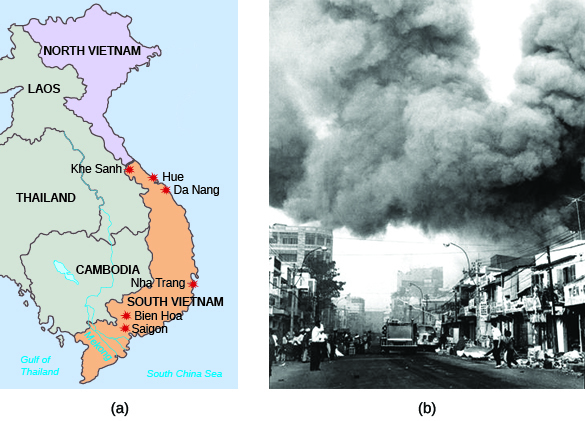| << Chapter < Page | Chapter >> Page > |
Westmoreland’s predictions were called into question, however, when in January 1968, the North Vietnamese launched their most aggressive assault on the South, deploying close to eighty-five thousand troops. During the Tet Offensive, as these attacks were known, nearly one hundred cities in the South were attacked, including the capital of Saigon ( [link] ). In heavy fighting, U.S. and South Vietnamese forces recaptured all the points taken by the enemy.

Although North Vietnamese forces suffered far more casualties than the roughly forty-one hundred U.S. soldiers killed, public opinion in the United States, fueled by graphic images provided in unprecedented media coverage, turned against the war. Disastrous surprise attacks like the Tet Offensive persuaded many that the war would not be over soon and raised doubts about whether Johnson’s administration was telling the truth about the real state of affairs. In May 1968, with over 400,000 U.S. soldiers in Vietnam, Johnson began peace talks with the North.
It was too late to save Johnson himself, however. Many of the most outspoken critics of the war were Democratic politicians whose opposition began to erode unity within the party. Minnesota senator Eugene McCarthy, who had called for an end to the war and the withdrawal of troops from Vietnam, received nearly as many votes in the New Hampshire presidential primary as Johnson did, even though he had been expected to fare very poorly. McCarthy’s success in New Hampshire encouraged Robert Kennedy to announce his candidacy as well. Johnson, suffering health problems and realizing his actions in Vietnam had hurt his public standing, announced that he would not seek reelection and withdrew from the 1968 presidential race.
Perhaps the greatest casualty of the nation’s war in Vietnam was the Great Society. As the war escalated, the money spent to fund it also increased, leaving less to pay for the many social programs Johnson had created to lift Americans out of poverty. Johnson knew he could not achieve his Great Society while spending money to wage the war. He was unwilling to withdraw from Vietnam, however, for fear that the world would perceive this action as evidence of American failure and doubt the ability of the United States to carry out its responsibilities as a superpower.
Vietnam doomed the Great Society in other ways as well. Dreams of racial harmony suffered, as many African Americans, angered by the failure of Johnson’s programs to alleviate severe poverty in the inner cities, rioted in frustration. Their anger was heightened by the fact that a disproportionate number of African Americans were fighting and dying in Vietnam. Nearly two-thirds of eligible African Americans were drafted, whereas draft deferments for college, exemptions for skilled workers in the military industrial complex, and officer training programs allowed white middle-class youth to either avoid the draft or volunteer for a military branch of their choice. As a result, less than one-third of white men were drafted.
Although the Great Society failed to eliminate suffering or increase civil rights to the extent that Johnson wished, it made a significant difference in people’s lives. By the end of Johnson’s administration, the percentage of people living below the poverty line had been cut nearly in half. While more people of color than whites continued to live in poverty, the percentage of poor African Americans had decreased dramatically. The creation of Medicare and Medicaid as well as the expansion of Social Security benefits and welfare payments improved the lives of many, while increased federal funding for education enabled more people to attend college than ever before. Conservative critics argued that, by expanding the responsibilities of the federal government to care for the poor, Johnson had hurt both taxpayers and the poor themselves. Aid to the poor, many maintained, would not only fail to solve the problem of poverty but would also encourage people to become dependent on government “handouts” and lose their desire and ability to care for themselves—an argument that many found intuitively compelling but which lacked conclusive evidence. These same critics also accused Johnson of saddling the United States with a large debt as a result of the deficit spending (funded by borrowing) in which he had engaged.
Lyndon Johnson began his administration with dreams of fulfilling his fallen predecessor’s civil rights initiative and accomplishing his own plans to improve lives by eradicating poverty in the United States. His social programs, investments in education, support for the arts, and commitment to civil rights changed the lives of countless people and transformed society in many ways. However, Johnson’s insistence on maintaining American commitments in Vietnam, a policy begun by his predecessors, hurt both his ability to realize his vision of the Great Society and his support among the American people.

Notification Switch
Would you like to follow the 'U.s. history' conversation and receive update notifications?